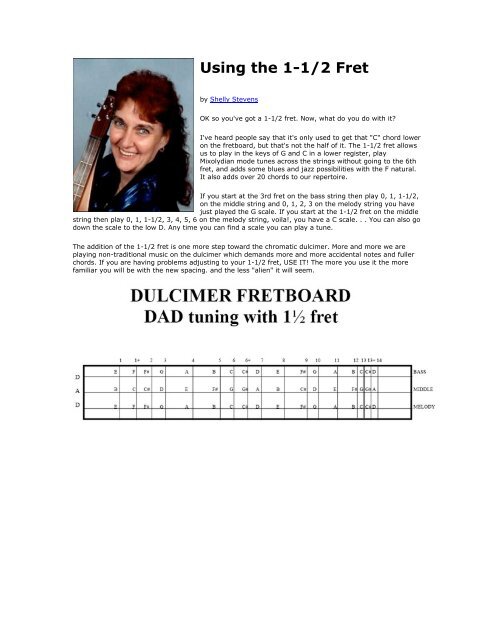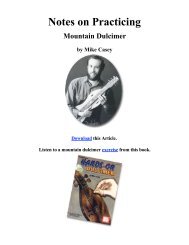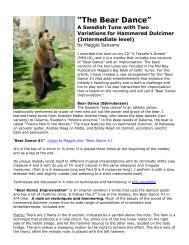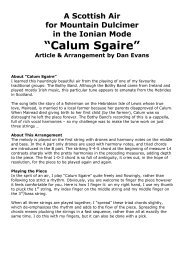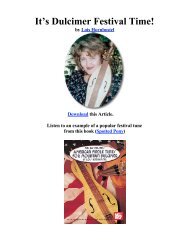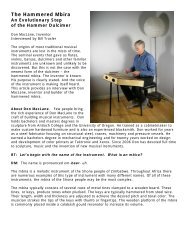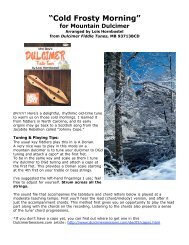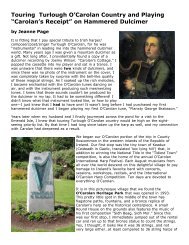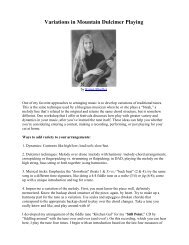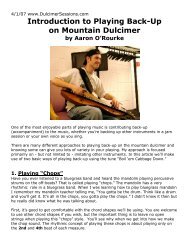Using the 1-1/2 Fret - Mel Bay's Dulcimer Sessions
Using the 1-1/2 Fret - Mel Bay's Dulcimer Sessions
Using the 1-1/2 Fret - Mel Bay's Dulcimer Sessions
You also want an ePaper? Increase the reach of your titles
YUMPU automatically turns print PDFs into web optimized ePapers that Google loves.
<strong>Using</strong> <strong>the</strong> 1-1/2 <strong>Fret</strong><br />
by Shelly Stevens<br />
OK so you've got a 1-1/2 fret. Now, what do you do with it?<br />
I've heard people say that it's only used to get that "C" chord lower<br />
on <strong>the</strong> fretboard, but that's not <strong>the</strong> half of it. The 1-1/2 fret allows<br />
us to play in <strong>the</strong> keys of G and C in a lower register, play<br />
Mixolydian mode tunes across <strong>the</strong> strings without going to <strong>the</strong> 6th<br />
fret, and adds some blues and jazz possibilities with <strong>the</strong> F natural.<br />
It also adds over 20 chords to our repertoire.<br />
If you start at <strong>the</strong> 3rd fret on <strong>the</strong> bass string <strong>the</strong>n play 0, 1, 1-1/2,<br />
on <strong>the</strong> middle string and 0, 1, 2, 3 on <strong>the</strong> melody string you have<br />
just played <strong>the</strong> G scale. If you start at <strong>the</strong> 1-1/2 fret on <strong>the</strong> middle<br />
string <strong>the</strong>n play 0, 1, 1-1/2, 3, 4, 5, 6 on <strong>the</strong> melody string, voila!, you have a C scale. . . You can also go<br />
down <strong>the</strong> scale to <strong>the</strong> low D. Any time you can find a scale you can play a tune.<br />
The addition of <strong>the</strong> 1-1/2 fret is one more step toward <strong>the</strong> chromatic dulcimer. More and more we are<br />
playing non-traditional music on <strong>the</strong> dulcimer which demands more and more accidental notes and fuller<br />
chords. If you are having problems adjusting to your 1-1/2 fret, USE IT! The more you use it <strong>the</strong> more<br />
familiar you will be with <strong>the</strong> new spacing. and <strong>the</strong> less "alien" it will seem.
My style of playing is to play a chord at <strong>the</strong> beginning of a measure and hold it down throughout <strong>the</strong><br />
measure while playing <strong>the</strong> melody on <strong>the</strong> melody (treble) or middle string. You'll find this helps to smooth<br />
out your playing and makes <strong>the</strong> music flow from your instrument. Keep your fingers ON <strong>the</strong> strings. When<br />
you lift your left hand <strong>the</strong> music stops, making your playing sound choppy. Slide up and down <strong>the</strong><br />
fretboard and not only will your playing be smoo<strong>the</strong>r but you will also have less problems finding your<br />
chords.
I am a firm believer in using all <strong>the</strong> fingers you have (including your thumb) on your left hand. This will<br />
increase your speed and will broaden <strong>the</strong> range of notes you can play. For example in <strong>the</strong> following<br />
measure:<br />
(bass string) 2<br />
(middle string) 3<br />
(melody string) 4 5 4 3 2<br />
I would form and hold<br />
<strong>the</strong><br />
2<br />
chord with my middle finger on <strong>the</strong> 2, index finger on <strong>the</strong> 3 and thumb on <strong>the</strong><br />
3<br />
4.<br />
4<br />
Then moving my thumb to play <strong>the</strong> 5 and 4 and 3, and using my little finger for <strong>the</strong> 2 and 1 allows <strong>the</strong><br />
chord to ring throughout <strong>the</strong> entire measure and very little hand movement is required. Don't be<br />
discouraged by a sore little finger. You will soon develop a callous.<br />
For<br />
<strong>the</strong><br />
3<br />
1-<br />
1/2<br />
1<br />
melody string.<br />
chord I find that I use my index finger on <strong>the</strong> bass, ring finger on <strong>the</strong> middle and little finger<br />
on <strong>the</strong><br />
This lets me use my thumb to play <strong>the</strong> melody and readies my middle finger to change chords. Most of <strong>the</strong><br />
tunes played in <strong>the</strong> key of C end with <strong>the</strong> note on <strong>the</strong> middle string. You can mute <strong>the</strong> melody string by<br />
resting your finger on it lightly - just enough to deaden <strong>the</strong> string without fretting it. That will prevent it<br />
from accidentally sounding when you play <strong>the</strong> final chord. If at all possible I recommend using a shorter<br />
scale fretboard (a size similar to McSpadden's Ginger dulcimer or Ron Ewing's Baritone Dulcimette) for<br />
<strong>the</strong>se arrangements. This will make playing easier.<br />
In my book <strong>Using</strong> <strong>the</strong> 1-1/2 <strong>Fret</strong> I have included 26 tunes in <strong>the</strong> keys of D, G and C that will help you to<br />
use <strong>the</strong> 1-1/2 fret to its full potential. It is my hope that you will enjoy <strong>the</strong> arrangements in <strong>the</strong> book and<br />
that it inspires you to broaden your playing in o<strong>the</strong>r keys. The book is available through my secure<br />
shopping web site.
Listen to Shelley Stevens play "Abide With Me" in an arrangement using <strong>the</strong> 1-1/2 fret (written as '1+' in<br />
her tablature).
About <strong>the</strong> Author<br />
Shelley Stevens has been playing music for most of her life but for <strong>the</strong> last 22 years has considered <strong>the</strong><br />
mountain dulcimer to be her primary instrument. She has made it her life's work to dispel <strong>the</strong> notion that<br />
<strong>the</strong> instrument must only be used for traditional music and has arranged music of many styles to <strong>the</strong><br />
dulcimer. Shelley has taught workshops at festivals in <strong>the</strong> Eastern and Central U.S., including Appalachian<br />
State University in Boone, NC; Morehead University in Morehead, KY; Shady Grove <strong>Dulcimer</strong> Camp at<br />
Urbana University in Urbana, OH; Heritage <strong>Dulcimer</strong> Camp in Kansas City, MO; NGFDA Fall Festival in<br />
Helen, GA; and <strong>the</strong> Ozark Folk Center in Mountain View, AR. Shelley also teaches all levels privately.<br />
Shelley is a founding member of "Sweetwater," a trio of women who have played and sung <strong>the</strong>ir way<br />
across <strong>the</strong> United States, Canada, Ireland and <strong>the</strong> British Isles. They have recorded several albums on<br />
<strong>the</strong>ir Tweetwater Productions label.<br />
As well as doing lead and harmony vocals, Shelley plays several instruments with "Sweetwater," including<br />
<strong>the</strong> mountain dulcimer, stand-up bass and guitar. Shelley also performs as a solo artist and with o<strong>the</strong>r<br />
bands.<br />
Bibliography/Discography Shelley's first dulcimer tablature book, O'Carolan Harp Tunes for <strong>the</strong><br />
Mountain <strong>Dulcimer</strong>, was published by <strong>Mel</strong> Bay Publications in 1993 and in 1998 her book Stephen Foster<br />
for <strong>the</strong> Mountain <strong>Dulcimer</strong> was published again by <strong>Mel</strong> Bay. Shelley was also included in <strong>Mel</strong> <strong>Bay's</strong> 2000<br />
<strong>Dulcimer</strong> compendium and Susan Trump's CD, "Masters of <strong>the</strong> Mountain <strong>Dulcimer</strong>, Volume 2."<br />
Shelley has published o<strong>the</strong>r tablature books through Tweetwater Productions. Among <strong>the</strong>se are The Three<br />
String Orchestra Volumes I and II (dulcimer books of all classical music arrangements) and The Baker's<br />
Dozen, a series of 11 dulcimer tablature books, each a different style of music. Her latest is <strong>Using</strong> <strong>the</strong> 1-<br />
1/2 <strong>Fret</strong>, a primer for 1-1/2 fret users.<br />
In 2004 Shelley completed her first solo album entitled "Songs of Life, Love and Laughter," which includes<br />
music from classical to country & ragtime to rock as well as music to tickle your funny-bone! This is an<br />
enhanced CD which contains photos and links to her web site and e-mail.<br />
Visit Shelley's web site at www.shelleystevens.com for free tab every month and secure on-line shopping<br />
for her books and CDs.


